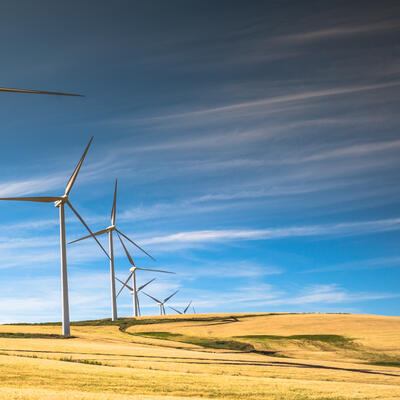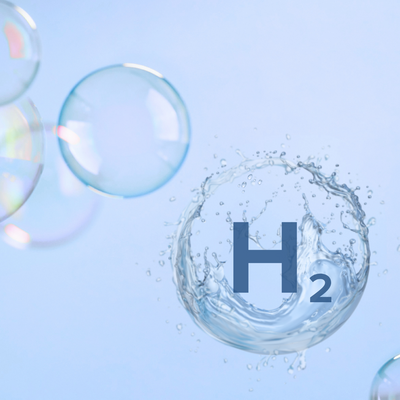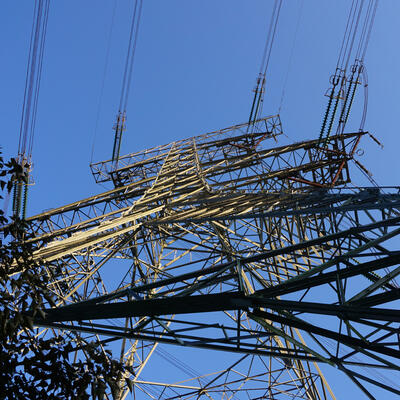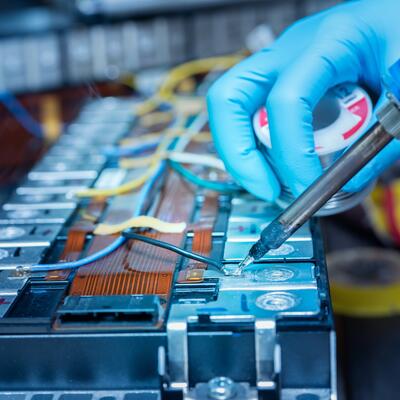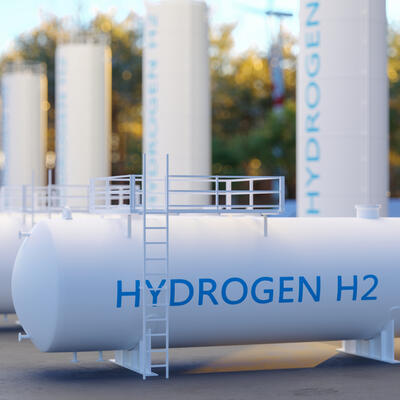
Has Hydrogen’s Moment Finally Arrived?
Guests

Sunita Satyapal

Julio Friedmann

Alan Krupnick
Summary
For decades, hydrogen has been considered the fuel of the future. Now, with a slew of new U.S. tax incentives, research and funding, its moment may have finally arrived. Hydrogen is the first element in the periodic table – the lightest element and the most abundant. Currently it’s used in many different applications: from steel manufacturing to ammonia and fertilizer. But it also has potential as a renewable fuel source and for long-term energy storage.
Today most hydrogen is made by splitting apart methane, a process which produces carbon dioxide pollution. Alan Krupnick, a senior fellow at Resources for the Future, is a proponent of what’s called “blue” hydrogen, where the carbon emissions from this process are captured and stored.
“You can get anywhere from 60 to 90 percent of the CO2 out, so let's do that first,” he says. “If we stop ourselves from using the resources we have, just because of a philosophical issue of keeping it in the ground, that seems to be tying one hand behind our back.”
Krupnick anticipates that this method will be the first approach to cleaning up hydrogen production, partly because of the low cost of fossil gas.
Electrolysis, which splits hydrogen and oxygen from water, can make so-called “green” hydrogen if the power used is zero-emission. But electrolysis takes a lot of energy and thus is often quite expensive, says Julio Friedmann, chief scientist and chief carbon wrangler at Carbon Direct.
“It's hard to make large volumes of [green hydrogen] today cause we don't have the infrastructure supply chains to do it. It'll take some time to build that out. Eventually though, that will be the cheapest pathway, and it will be the most ubiquitous pathway,” he says, helped in part by new tax incentives in the Inflation Reduction Act, along with federal investments in renewable power facilities and transmission systems.
More widespread production and use of clean hydrogen could also play a role in shaking up global energy politics.
“If you have a bunch of distributed fuel producers around the world, then it does change the way that a country, say, like Russia, would think about its ability to leverage its energy power,” says Friedmann.
Dr. Sunita Satyapal is the director for the U.S. Department of Energy’s Hydrogen and Fuel Cell Technologies Office. She’s had a long career in hydrogen, working at the Department of Energy for close to two decades and in industry before that. She says this moment is different from any other.
“All the pieces of the puzzle are starting to be put in place. We have amazing policies and incentives. The administration has been really focused on how can we address the climate crisis. We have governments around the world and industry investments, hundreds of billions. And part of the reason is that countries are seeing that they need to have a carbon-free option other than electrification to meet their climate goals,” she says. “So I think there's huge potential for hydrogen, but a lot of challenges we still have to address: production, delivery, storage, end use, cost, performance. I think this is a critical time to make sure we get all those pieces right.”
Highlights:
2:38 Julio Friedmann on ways to make hydrogen
6:39 Water usage
8:24 Best uses of hydrogen
14:45 Shipping hydrogen
19:10 Hydrogen’s role in global energy markets
25:32 Sunita Satyapal on this critical moment for hydrogen
28:14 Alan Krupnick on cleaning up existing hydrogen with carbon capture
33:54 Hydrogen Shot initiative
36:13 New federal tax incentives
39:09 Hydrogen hubs
44:29 Hydrogen for long-haul trucking
48:43 Hydrogen leaks impact on GHG emissions
Related Links:
Hydrogen Shot
A Hydrogen Future? Exploring Pathways to Decarbonization
Nuclear Support Grows Amid Push for Clean Hydrogen
Turning Down the Heat: Decarbonizing Cement and Steel
Episode Highlights
2:38 Julio Friedmann on ways to make hydrogen
6:39 Water usage
8:24 Best uses of hydrogen
14:45 Shipping hydrogen
19:10 Hydrogen’s role in global energy markets
25:32 Sunita Satyapal on this critical moment for hydrogen
28:14 Alan Krupnick on cleaning up existing hydrogen with carbon capture
33:54 Hydrogen Shot initiative
36:13 New federal tax incentives
39:09 Hydrogen hubs
44:29 Hydrogen for long-haul trucking
48:43 Hydrogen leaks impact on GHG emissions
Full Transcript
Note: Transcripts are generated using a combination of automated software and human transcribers, and may contain errors. Please check the actual audio before quoting it.
Ariana Brocious: This is Climate One. For decades, hydrogen has been considered the fuel of the future. Now, with a slew of new U.S. tax incentives, research and funding, its moment may have finally arrived.
Sunita Satyapal: Countries are seeing that they need to have a carbon-free option other than electrification to meet their climate goals.
Ariana Brocious: There are debates about how best to make clean hydrogen, and how much we should continue to rely on hydrogen made from fossil fuels.
Alan Krupnick: If we stop ourselves from using the resources we have, just because of a philosophical issue of keeping it in the ground, that seems to be tying one hand behind our back.
Ariana Brocious: And how could more widespread production and use of hydrogen shake up global energy politics?
Julio Friedmann: If you have a bunch of distributed fuel producers around the world, then it does change the way that a country, say, like Russia, would think about its ability to leverage its energy power.
Ariana Brocious: Has Hydrogen’s Moment Finally Arrived? Up next on Climate One.
Ariana Brocious: This is Climate One, I’m Ariana Brocious.
Greg Dalton: And I’m Greg Dalton. Hydrogen is the first element in the periodic table–the lightest element and the most abundant.
Ariana Brocious: Of course hydrogen is part of that famous duo, H2O, and methane, CH4, but we also interact with it in tons of other ways – to make steel, ammonia, and fertilizer.
Greg Dalton: Right. And for more than a decade I’ve heard people talking about hydrogen as this futuristic fuel - for transportation and other purposes - that would solve a bunch of climate challenges, because it can be zero-emission. I learned a lot about that from my late friend John Hofmeister, who ran Shell Oil in the US.
Ariana Brocious: Where did John land on hydrogen?
Greg Dalton: He was a proponent of hydrogen and I was, and remain, a skeptic, and yet we debated its merits over the years, vigorously and amicably. I miss him and those debates. I want to give a nod to John on the show today, as we reconsider hydrogen as part of a clean energy system.
Ariana Brocious: If we want to employ hydrogen in that way, we first have to split it from those other elements. That takes energy, often a lot. I asked Dr. Julio Friedmann, chief scientist and chief carbon wrangler at Carbon Direct, to help us start with an understanding of the various ways we can produce hydrogen.
Julio Friedmann: The goal here is to make low carbon hydrogen. And so there's lots of different ways to do that. People have adopted a color scheme that I find counterproductive. The goal here is really about the hydrogen, not the core tech or the core pathway. If you can get a low carbon intensity over the whole life cycle, including upstream emissions and everything, that's what you want to do. Today we basically make hydrogen by splitting it off of methane and venting the carbon dioxide. Typically something like a steam methane reforming unit. That produces itself about 2% of global emissions, not great. So there's other ways that you can make hydrogen without the carbon emissions. Straightforward way is to do it the same way we're doing today, but actually capture and store those CO2 so we don't emit it. That is commonly called blue hydrogen. You would have to worry about the upstream methane emissions and so forth from it, but if you do it all right, you can have a very, very low carbon intensity. The other way that we make hydrogen is grade school chemistry. You run electricity through water and you need to have a lot of electricity, but it works just fine. Sometimes that is called green hydrogen. And the important thing here is if you want to have a low carbon footprint, the electricity has to have a low carbon footprint. So for example, if you made it from solar and wind, that has a low carbon footprint, so does nuclear, but if you pull it off the grid, the electricity will void the carbon benefits of that hydrogen. You will end up emitting more than you avoid.
Ariana Brocious: So what are the pros and cons of getting hydrogen from water versus from methane?
Julio Friedmann: Really what you are looking for is low carbon content, and if you get it from renewable electricity and water, that's great, but one of the cons is today that's very expensive, roughly speaking, three times more expensive if you're lucky, seven times more expensive in some places of the world. And that's just because clean electricity costs so much and you need so much of it. In some places though, like Sweden, that's not true. It is twice as expensive as gray hydrogen, but that's inbounds. For the fossil hydrogen it is actually faster to decarbonize through something like carbon capture, but, uh, you do actually have to keep an eye on those upstream emissions. Uh, if you have fugitive methane emissions, then that adds a lot of greenhouse gas warming to the atmosphere. Electrolyzers and green hydrogen today are all pretty small. It's hard to make large volumes of the stuff today cause we don't have the infrastructure or supply chains to do it. It'll take some time to build that out. Eventually though, that will be the cheapest pathway and it will be the most ubiquitous pathway.
Ariana Brocious: So green hydrogen, which we've been talking about, using renewable energy to split water into hydrogen and oxygen is a pretty good climate win. What are the barriers to cost effective green hydrogen production?
Julio Friedmann: Yeah. Friendly amendment: It's not renewable power, it's zero carbon power. We have lots of ways to do that. Hydropower, geothermal, nuclear, solar, onshore wind, offshore wind, all of those are ways to do it. And in fact, one of the big problems is people get hung up on that. Right now there is a big fight in Europe over whether nuclear based hydrogen is considered green or not, and they are losing time and money on that debate, which is fundamentally counterproductive. There are things you have to do though to make this stuff. Because it requires so much energy, you do need a whole lot of clean electricity to make clean hydrogen. We are gonna face challenges with infrastructure in the near term. We don't have the transmission systems, we don't have the renewable power facilities we need in order to generate that green hydrogen today. Typically 50 to 70% of the cost is just the cost of the electricity. So until we can really get super cheap, super clean electricity, green hydrogen is gonna keep facing that challenge. We can overcome that with things like policy in the Inflation Reduction Act, for example, we've added a production tax credit for clean hydrogen of all kinds. That's great. $3 a kilogram. It goes a long way to making that accessible to the market, but not in all markets. Not in all jurisdictions, and not for all applications.
Ariana Brocious: And what about water usage?
Julio Friedmann: This is a question that commonly comes up because the recipe for hydrogen is water plus electricity. It turns out though, you don't need very much water. The water has to be very high quality or else the equipment gets broken, but you can make a lot of hydrogen with not much water. So a cubic meter of water is a ton of water that has about 200 kilograms of hydrogen in it. If you scale that up, To a million tons of hydrogen. You're talking about 5 million cubic meters of water. That's just not that much. That's a few seconds of a big river's flow. And even in water scarce areas like the Atacama Desert Water is not the rate limiting step.
Ariana Brocious: And maybe we could look at it as comparing the water use for hydrogen production, to some other forms of energy production like natural gas, which requires a lot of water for fracking. Is there, do you have at your fingertips like a rough comparison of how much water that might take?
Julio Friedmann: It's not a straightforward comparison. To do a single frack job you will use 80 trucks full of water, but you don't know how much gas you get from that. You don't know how much it costs. Like it's hard to make that comparison. It is true though, that as we think about water in all of these systems, the water requirements for this clean hydrogen are much lower than most energy systems. We use the cooling water for nuclear plants, the fracking for gas plants. The byproduct produced water from oil production. Like all of that is much more than the kind of water we're talking about in hydrogen.
Ariana Brocious: So we've talked about hydrogen production. Let's talk about hydrogen use. From a climate perspective, what do you see as the best applications of hydrogen?
Julio Friedmann: So reasonable people disagree about this, but most experts choose the same stuff as the killer apps for hydrogen, and one of those is as a feedstock for clean fuels. To make things like ammonia or to make things like sustainable aviation fuel, you want clean hydrogen in that. A really critical killer app is fertilizer specifically again, ammonia for fertilizer. Half the hydrogen in the world goes to that today. And in fact, half the nitrogen atoms in your body came from food you ate from fertilizer. So, that is a really good place to do it today. And it's an existing market that's obvious, again, fertilizer production, about 2% of global emissions. So decarbonizing that is an easy win and pretty straightforward. After things like superclean fuels and fertilizer, heavy industry is the next thing where most people agree. Things like steel mills can be rebuilt for hydrogen. You can start using them today in chemical plants and cement plants. So these are good uses to decarbonize the very hard to abate stuff. The one place I think we are going to use, almost none of it, is in passenger vehicles. Light duty vehicles are a poor use of hydrogen today. One of the more contentious uses is for home heating. And in many homes something like a heat pump is a better way to go. We have limits to how much of that we can get and so forth, but other kinds of heating applications are harder to understand, are facing challenges. And so that is the point where a lot of people find friction. Should we be using hydrogen to heat our homes? In my humble opinion, we got a long way to go before that's the primary question. The primary question is how do we make it for things like fertilizer, fuels and heavy industry?
Ariana Brocious: Right. And you mentioned passenger vehicles, it not being a good fit for that. But what about, long haul trucking and, and freight?
Julio Friedmann: Yeah, so for a small distance trucking for fleets of trucks, batteries are probably a better bet. But for really long distance trucking, when you're driving from LA to New York, when you're driving from Houston to Seattle, batteries are not a great fit for that application. Something like liquid hydrogen or a clean fuel like methanol or ammonia made from clean hydrogen, that may be a better fit. And in Europe probably not cause the distances are short in North America, probably so.
Ariana Brocious: So let's talk about grid scale energy storage. Say there's a wind or solar plant wanting to store its renewable energy when the wind isn't blowing or the sun isn't shining. So one option would be to use electricity to split water into hydrogen and oxygen, and store the hydrogen in a tank. Then when the power is needed, put the hydrogen in a fuel cell, recombine it with oxygen, make water again, and then thus make electricity. Is that about how it works?
Julio Friedmann: Effectively, yes, for short term electricity needs like on a four hour or eight hour basis. Again, batteries are already cheaper and more widely available, but for seasonal fluctuations, a seasonal intermittency, we don't have good solutions. In Germany, they have a period of time called the dunkleflauter, where for a whole month there's basically no wind and it's really cold and it's really dark. That would be good to have a month's worth of clean electricity, and if you're banking the hydrogen at some other part of the year, then you can do that. A friendly amendment to your question: People imagine that it's a tank and there will be some tanks, but a really good way to store it is in Salt Caverns, the same way we store this strategic petroleum reserve, and this is a real thing. In Utah they're building a big green hydrogen turbine facility and they're building a big hydrogen storage facility and salt cavern they're making there. And one salt cavern, if it were filled with hydrogen, would equal 150 times all the batteries in the US.
Ariana Brocious: Wow.
Julio Friedmann: Like it's a lot of storage and so that is very hard to beat. And there's a big value proposition to utilities, to the government, to customers, to use hydrogen for these difficult in long-term intermittencies.
Ariana Brocious: And does it expire in any way or lose potency? I mean, I, it's an element, so I assume if it's well sealed, it'll just hold its energy potential until you need it.
Julio Friedmann: Correct. It doesn't lose energy over time. Unlike a battery, the hydrogen molecule does the same thing. There's a separate concern though, which is around leakage. Hydrogen is a very small, slippery molecule, so you have to make sure it doesn't leak. You can lose volume, which is losing energy if you do that. Also, hydrogen leakage has some knock on climate effects. It is not a greenhouse gas itself, but it does impact greenhouse gas concentrations in the atmosphere because it scavenges the molecules that themselves take out methane and nitrous oxides. So a lot of hydrogen leakage would actually extend the lifetime of some greenhouse gasses in the atmosphere. We are starting to understand that, but we know how to make a good hydrogen tank. We know how to make a good hydrogen salt dome. There are already two hydrogen salt domes in the US so we know how to do this well with minimal leakage. The question is, will we do it?
Ariana Brocious: So there are a lot of solar and wind projects that are ready to go now, but they're waiting on interconnection with the electric grid. And I'm wondering about the potential for distributed hydrogen energy generation with some of these projects. So say that there's a solar farm and they could just put an electrolyzer there and make the power locally, use it locally, and then it wouldn't have to be shipped across the grid. Is that possible?
Julio Friedmann: It is possible. I don't think it solves all the problems because we don't have the grid in the United States. We have three grids with complex rules. And all these other sorts of things. We know that it is very, very hard to build transmission lines in this country. Typically 10 to 20 years to build a transmission line. And even then it might not be built. So we could make hydrogen or an intermediate fuel like ammonia and ship that instead. Hydrogen is hard to ship. You can put it in tube trucks and drive it around, but it's not a great way to move hydrogen. Something like ammonia is a better bet, but just for storing it and dispatching it some other time, yeah, that's something you could do pretty quickly.
Ariana Brocious: So let's talk about another scenario. Let's say I'm in North Africa, Morocco, maybe, or Egypt, and could build a huge solar farm, but the market for electricity is in Europe. As we're just discussing the ways of moving hydrogen, how might I use hydrogen as a means of shipping that power?
Julio Friedmann: This is a new idea that people are just getting their hands around, but the global south is potentially a massive hydrogen superpower. They have incredible renewable resources in the form of solar onshore and offshore wind, hydro, and places like Chile or Namibia, or Rajasthan, which is Northwestern India. Indonesia. These are places where they could make enormous volumes of green hydrogen with renewables. They can't ship the hydrogen, but they can ship the ammonia, and it is already the case that Namibia and Chile have long-term offtakes for ammonia made with clean hydrogen. That is not only good for the country because it creates wealth, that is not only good for the climate cause it avoids, reduces, abates actual emissions. It also shakes up the geopolitics of energy quite a bit. If you have a bunch of distributed fuel producers that are making clean fuels around the world, then it does change the way that a country say, like Russia would think about its ability to leverage its energy power.
Ariana Brocious: Mm-hmm. That's really interesting. From a technical standpoint, how do we get the hydrogen back out of the ammonia? And how expensive is that?
Julio Friedmann: So in some cases you can just use the ammonia as a fuel. Japan and Korea have said they will do that. They will use ammonia to coal-fire, their existing power fleet, and they will buy clean ammonia at a premium and they will use it to meet their climate targets. In the United States, that's really unlikely. We have much better options, so we are less likely to do ammonia combustion ourselves, but we might ship the ammonia or we might use it for a truck or a maritime fuel or something like that. Today, the way that we get hydrogen out of ammonia is a big chemical process called ammonia cracking, and that requires a big billion dollar facility just to do that at scale. Thankfully, there are innovators who have novel technologies that are containerized, that are small, that are modular, that can do that hydrogen cracking all on their own. And the technology that they use is actually based on light, it's photocatalytic and those technologies can eventually actually produce green hydrogen themselves.
Ariana Brocious: And then what about a pipeline? Can we transport hydrogen that way versus ammonia?
Julio Friedmann: Most people will be surprised to hear this. The United States already has 1200 miles of hydrogen pipelines. We've had those for a long time. They are regulated by the Department of Transportation, FHMSA, the pipeline, Hazardous Safety Materials Act. They take care of this. The number of incidents we've had on hydrogen failures and disasters has been zero. We have been operating it very safely for a very long time. It is also the case that we have 10,000 miles of ammonia pipelines in this. , which most people don't know either. It takes ammonia from the Gulf of Mexico up to the bread basket to the heartland. And so we can and certainly do this already, whether or not we can do more of it is a different question, but there's no technical reason why we can't have hydrogen pipelines or ammonia pipelines. An important caveat to that. Existing pipelines that are not built for hydrogen are bad ideas. We do not wanna just start throwing hydrogen into existing pipelines willy-nilly. In most cases, the maximum that we could take is about 5% hydrogen blend before things start to come off the rail. Maybe 10% in some places, but if you have a cast iron pipeline, don't put hydrogen into it. That's a bad idea. But if you have a PVC pipeline, no problem, you can go up to a hundred percent hydrogen. So we need to reimagine our infrastructure in the context of hydrogen if we wanna deploy it for certain kinds of things.
Ariana Brocious: Russia's invasion of Ukraine a year ago rattled the global energy markets, and especially in Europe, it put a new emphasis on hydrogen to replace Russian gas. So how is that effort going and is that a viable solution?
Julio Friedmann: Yes. Russia's war of aggression in the Ukraine reminded us that not everyone cares about climate alone. Energy security is suddenly a thing. Economics and cost of energy are suddenly a thing. The incredible rise in price of natural gas basically tripled the price of fertilizer around the world. It has created a food crisis, so it has accelerated focus on a transition to green hydrogen in Europe. How is it going? Not great. Part of the reason why is because they have been tied up in knots about questions of purity, and when I say purity, is green hydrogen defined as renewable or not? And if it's coming from nuclear power, a lot of countries think that's a bad idea and the European Commission is having a hard time managing that discussion. It is also the case that they do not have the infrastructure to do that today. They don't have the transmission power lines for green hydrogen. They don't have the storage tanks, they don't have the electrolyzer manufacturing capacity. They're doing their best to fix that, but that's at best a 2025 solution. 2023, if they have a cold winter, there'll still be a whole lot of hurt. One of the pluses in Europe though, is that their infrastructure is more compatible with hydrogen. Today they can put, say 20 to 40% hydrogen into most of their pipelines and reduce their dependence on Russian gas that way. The problem is making it, and they are in the near term, looking to import a lot of clean ammonia and convert that back to hydrogen, mostly in heavy industrial ports, places like Rotterdam or RP where they have huge demands for hydrogen, for fertilizer and for chemicals, they can pull back their natural gas demand by bringing in ammonia for those plants.
Ariana Brocious: So 20 years ago, the joke was that hydrogen is the fuel of the future and will always be. What's changed?
Julio Friedmann: The big thing that's changed is that this is about climate now. The IPCC’s 1.5 degree report in 2018 really shook up the gumball machine and it reframed climate discussion entirely as a net zero enterprise. If you gotta get to net zero, that is all sectors everywhere in the world very fast. At that point, hydrogen looks interesting, it looks interesting for the things you cannot electrify easily again, like steel or airplanes or ships. It looks interesting in terms of providing high temperature heat that is clean. Today, all of that high temperature heat comes from fossil fuels, so we need a good option for that. And green hydrogen looks like a good option for that. Last but not least, the technology has moved forward a lot. We have much better confidence in things like electrolyzers. The costs of renewable power have dropped dramatically. The confidence with which we deploy carbon capture has improved dramatically. All these things have made it much, much more interesting and accessible, and that has made it easier for policymakers to pass things like the IRA provisions, the 45 V tax credits to incent clean hydrogen production.
Ariana Brocious: Julio Friedman is Chief Scientist and Chief Carbon Wrangler at Carbon Direct. Thank you so much for joining us on Climate One.
Julio Friedmann: This was a real treat. Thank you.
Ariana Brocious: This is Climate One. I’m Ariana Brocious. Today we’re digging into hydrogen. We’ve already covered some of how it can be made and used. To get a bit further into potential applications and the role of federal funding and innovation, we invited two guests to join Climate One host Greg Dalton. Dr. Sunita Satyapal is the director for the U.S. Department of Energy’s Hydrogen and Fuel Cell Technologies Office. She’s responsible for more than $1.6 billion in hydrogen and fuel cell research, development, demonstration, and deployment. Alan Krupnick is a senior fellow at Resources for the Future and an expert on the oil and gas sector. Dr. Satyapal began by painting us a picture of all the ways we interact with hydrogen on a day-to-day basis.
Sunita Satyapal: There are actually many touchpoints. So for instance, the food that we eat relies on fertilizer that's made with hydrogen and the gasoline, for instance, that we use, refining uses hydrogen to remove impurities. And there's hydrogen that's used in food processing, for example, pharmaceuticals making chemicals. So methanol that ends up making plastics. There's so many examples where hydrogen is being used. We actually produce 10 million tons of hydrogen in the US, about 10% of the global capacity for existing uses. So it's a chemical commodity, but there are many other examples of where we see the potential for hydrogen. It's a carbon-free fuel, it can be used as a feedstock, it can be used to store energy. So I think there's just a lot of interest in its decarbonization potential, especially for those hard to decarbonize sectors.
Greg Dalton: And we'll get into some of those as we go forward in this conversation. As an energy source, hydrogen has had lots of ups and downs over the years. For 30 years, it's been about 10 years away. Sunita, you've had a long career in hydrogen, working at the Department of Energy for close to two decades, and in industry before that. Has hydrogen's moment finally arrived?
Sunita Satyapal: Yes, I’ve seen so many ups and downs both in industry and in government, and I think now is definitely different compared to all the previous times. I think we're not quite there yet, but the answer is yes. I think that moment has arrived and all the pieces of the puzzle are starting to be put in place. We have amazing policies and incentives. The administration has been really focused on how can we address the climate crisis. We have governments around the world and industry now, industry investments, hundreds of billions. And part of the reason is that countries are seeing that they need to have a carbon-free option other than electrification to meet their climate goals. And we've also seen the cost come down, technology advances. And so again, it's not just that technology push. We're starting to see that market pull and just that understanding that hydrogen can provide multiple options and that versatility that wasn't there before. So I think we're seeing that moment in time where we're seeing the technology, the market, the policies, all of those coming into play at the same time, so we have both the, hopefully sufficient supply, clean hydrogen demand, sustained offtake. So yes, I do think it is a critical moment in time for hydrogen.
Greg Dalton: Alan, Sunita mentioned a number of current uses of hydrogen: plastics industry. And those heavy industrial uses make environmentalists and others suspicious of hydrogen because of who favors it, particularly the oil and gas industry. What do you make of that?
Alan Krupnick: As an economist, I'm trying to view a world where we have all options on the table and not to somewhat arbitrarily take options off the table. So if the oil and gas industry is in favor of hydrogen, that's no reason in and of itself to reject it. It really depends on its cost and its environmental benefits. At the end of the day, that's what matters. Implications for environmental justice. I mean, there's a lot riding on the introduction of hydrogen and decarbonization in general, but just because some sector is for it doesn't mean anyone, in my view, should be against it.
Greg Dalton: Right. So no guilt by association. You know, Alan, a veteran energy executive in Silicon Valley wrote to me, I asked him, what do you think about hydrogen? And he wrote, “hydrogen and direct air capture are both being used to delay phasing out fossil fuels as quickly as possible.” Direct air capture is sucking CO2 out of the air directly. Do you agree, Alan, that hydrogen is being used as a delaying tactic?
Alan Krupnick: Well, again, what you ultimately care about is what's the least expensive and fastest way to clean things up. And actually, the hydrogen that Sunita mentioned, the uses in refining and in ammonia production, methanol production, the main use, this is dirty hydrogen. This is hydrogen that can actually be dirtier than using fossil fuels. So if you can clean up that hydrogen stream, and I think this is the first place we're gonna see a lot of action, if you can clean that up with carbon capture technologies, you can get anywhere from 60 to 90 percent of the CO2 out, so you know, let's do that first. And since the hydrogen is mostly made from natural gas, that is going to mean that we still use our natural gas. But let's not forget that the natural gas, because of the fracking revolution, is very cheap. Now it does have pollution attached to it, and most particularly methane emissions that can leak out at the site and through pipelines and processing and so on. But if you clean those up and then use carbon capture to capture the CO2 that comes out of the hydrogen process that uses the natural gas, this seems to me to be a perfectly acceptable way to move forward. If we artificially stop ourselves from using the resources we have, just because of a philosophical issue of keeping it in the ground that seems to be tying one hand behind our back.
Greg Dalton: Sunita, let's get you to respond to that. Most of the hydrogen use today is dirty. If we are gonna clean it up, carbon capture and sequestration the federal government spent billions of dollars on that hasn't really proved very effective so far. That seems to be all one of another one of those things that's always 10 years and a few more billion dollars away. Your response to Alan about cleaning up the hydrogen that's dirty now and we need to do that.
Sunita Satyapal: The challenge is that we still don't have the, it's such a nascent industry when it comes to, you know, electrolysis, which is the other approach, just splitting water. So using renewables or clean electricity, such as nuclear, taking water and producing hydrogen and oxygen. So again, it's such a nascent industry. And we have to meet our climate goals. The goals are net zero by 2050. That's only 27 years away, and so we have to scale again, as Alan said right now, if you think about the amount of hydrogen that's used, you know, globally, it's, it's, it's needed. You know, fertilizer. There are many, many examples and there's no other options right now. Most of that uses fossil fuels. And the emissions is, is huge. In fact, one of the statistics from the International Energy Agency is that the amount of CO2 just from hydrogen production today globally is more than the entire emissions of Indonesia and the UK combined. And so, we have to clean that up. So, let alone the new uses, cause it's a needed chemical in industry. And many call hydrogen the Swiss army knife of energy. So the fact that you can use multiple resources, so diverse domestic resources in any country. So using that natural gas with CCS. Of course, especially as a transition strategy as we scale up the use of renewables and other forms, biomass and so forth for clean hydrogen, it's just critical because we still need the demand side, the infrastructure, all of that growth that needs to happen, and we can't afford to wait for the perfectly clean, electrolytic hydrogen.
Alan Krupnick: I just wanna say something about the cleanliness of green hydrogen because, and I'm sure Sunita knows, if the electricity that you're using in the electrolysis, process is, kind of dirty, it doesn't need to be very dirty before this green hydrogen is not all that clean itself. So yeah, we usually think we need, let's say a dedicated solar field or a dedicated wind that is off the grid and would be used to power the hydrogen production process through electrolysis. But those instances are few and far between. And once you're pulling electricity from the grid, you've got fossil fuels, and that could be problematic.
Greg Dalton: Mm-hmm, even in some of the cleanest states have gas, et cetera. There's a lot of federal money coming into hydrogen now. One goal is to bring down the cost of produced hydrogen by 80% to a dollar per kilogram in a decade. Sunita, where does that effort stand to bring down the cost of hydrogen?
Sunita Satyapal: So when President Biden asked our Secretary of Energy Secretary Granholm, almost a couple of years ago, what can we do to really accelerate progress to address the climate challenge? And that was the beginning of the Energy Earth Shots Initiative. So many will remember the moonshot from over half a century ago. And the idea was to launch these big, bold, ambitious goals to really galvanize the global community. And so the very first was the hydrogen shots, and it has an easily articulated goal of 1 1 1, so $1 for one kilogram of clean hydrogen in one decade, and that's compared to the baseline cost, again, there are many assumptions here, of about five per kilogram. So we have research funding now with the bipartisan infrastructure law, billion dollars specifically for electrolysis, but we also have funding for deployments and demonstrations. So for example, the hydrogen hubs. And so it's really about bringing all those pieces together, the research, the demonstration, the scale up. And so we're starting to see costs down. We're planning to announce additional funding opportunities working on the cost of the electrolyzer. Again various components. Also the cost of the electricity. That's a huge contributor to that. So I think based on what we've seen, we've seen, you know, already probably about a dollar cost reduction from the time we've launched it, based on our estimates. And maybe one example since not everyone relates to a dollar per kilogram of hydrogen. So it's, you know, a little over two pounds, but one kilogram of hydrogen has about the same energy content as one gallon of gasoline. Though hydrogen actually has so much more energy content about three times more on a weight basis compared to gasoline. So when you use it, for instance, in a fuel cell, let's say in a vehicle, you go a lot further. So that cost again is pretty low. If we can get that cost down to about a dollar. And because hydrogen from natural gas today is only about a dollar 50, we really have to get that cost down to be competitive and, and really to get to scale.
Greg Dalton: And what I heard, I think you say Sunita, is that the price started around $5 a kilogram. You think it's come down about a dollar to four and the goal is to get to one. So you're 20% of the way there. Alan, there are new tax incentives at play now that are helping spur the industry to clean up industrial hydrogen production, which we've talked about is quite dirty. Can you sum them up and tell us how significant you think they'll be in cleaning up hydrogen, all this new federal money.
Alan Krupnick: Actually, in addition to the tax incentives, there's a hydrogen hubs program that I'm hoping will really push things along. So I'll mention all three. The two main tax incentives here and there are others, but the two that we look at shorthand is 45 Q and 45 V, and these refer to sections of the tax code. For tax credits. So the 45 Q is a tax credit for carbon capture utilization and storage, and the 45 V is for hydrogen. And so the hydrogen tax credit gets more and more generous as the hydrogen gets cleaner and cleaner from looking at the life cycle CO2 emissions.
Greg Dalton: Sounds positive.
Alan Krupnick: That sounds very positive. But how positive it really is is gonna hinge on the IRS rules cause the IRS, since it's a tax issue, the IRS has to write rules for what counts as, let's say green hydrogen versus blue or other colors of hydrogen that is blue hydrogen being hydrogen made with carbon capture. As I mentioned before, it's about the treatment of the electricity that goes into the electrolysis to qualify for that really big subsidy. And we don't know what will happen. And there is a trade off here because what you want is this tax subsidy to really jack up the hydrogen market and create lots of new projects. So if you're a hydrogen fan, you want the IRS rules with respect to electricity to be pretty favorable. But if you are an environmentalist and you want the CO2 to be reduced, you wanna be darn sure that that electricity is as clean as possible. And it's a tricky question, and we're all waiting with bated breath to see what'll happen. Now at the exact same time, you've got 48 Q, which doesn't necessarily have these problems because the subsidy doesn't depend on the life cycle. It's just like how many tons of carbon you capture. So, we think that in the short run, the 45 Q is actually the better bet for industry. And then they can create hydrogen using natural gas with carbon capture. And then finally, the hydrogen hubs program is a 8 billion-dollar program. It's gonna fund six to 10 hydrogen hubs and by a hub, that means it has producers and it has off takers, so demanders, from the hydrogen. And it's gonna be different hubs around the country. And this is a lot of money. This could be a billion dollars a hub, and it has to be matched by the private sector. So there's a lot that could happen here. A lot of action. And in fact, there have been 33 encouraged hub proposals that we're hoping will come into DOE and then DOE can choose among the best for jumpstarting this market for clean hydrogen.
Greg Dalton: And we'll get into the hubs in just a minute. But Alan, on the do the tax incentives for carbon capture utilization and storage amount of paying polluting industries to clean up their mess that they should do with shareholder dollars rather than taxpayer dollars.
Alan Krupnick: Well, we have in a sense, a dysfunctional Congress to blame for that,
Greg Dalton: That's a yes. Is that a yes?
Alan Krupnick: Well, we are paying polluters to clean up their mess. It's true. And that was the only recourse the administration had, these tax credits as well as more standard grants and loans that came through these infrastructure bill and the Inflation Reduction Act bills. But to get at the, to have the polluter pay, you need regulation. And economists like myself would favor some price on carbon that would provide incentives to reduce your CO2 emissions cost effectively, and that would probably give a boost to hydrogen as well. But that wasn't on the table.
Greg Dalton: So, so you prefer something, but what, what you would like wouldn't get through Congress. So we're kind of stuck with these tax things that were able to be done through reconciliation.
Alan Krupnick: Exactly. And it still can be quite effective, but it's gonna fail the polluter pay test.
Greg Dalton: So if you were to sum up Sunita for, someone, a friend who asked you, what are taxpayers getting out of these new programs and federal incentives, what's your elevator response to what we're getting for taxpayer money on hydrogen?
Sunita Satyapal: Even just looking at the progress, you know, a lot of people I think don't recognize how much has happened over the years. Just in our program alone, we have over 1200 patents that have been issued to companies, universities, labs, who've done the research and developed innovations. We have 30 technologies, actually another 65, that we think could be commercial in the next few years. And this ranges from even developing the electrolyzers or the fuel cells. And another example with a niche market, and this is an example with the American Recovery Act over a decade ago, and that was a really small amount of funding. It was about 40 million that we had in our office, and we demonstrated some of the very first, the world's first hydrogen fuel cell forklifts. And now we see over 50,000 hydrogen fuel cell forklifts. They're in the warehouses, major companies, in fact, like Amazon, Walmart, and so forth. Instead of having to wait to charge batteries, they have the quick fueling hydrogen forklifts that have completely zero emissions at the warehouses. In fact, every few seconds some customer is refueling with hydrogen. So, you know, our role, if you look at that, the government investment of helping to drive innovation and also to de-risk the technology and enable those first of a kind demonstrations so that now we can see scale in a real commercial viability and commercial liftoff, as we say. So I think everyone's getting more than their taxpayer dollars worth, considering, you know, all the work that's been going on in, in clean energy and in hydrogen.
Greg Dalton: And Alan, what would you be your one or two sentences on what taxpayers are getting for all these billions of dollars directed toward hydrogen?
Alan Krupnick: Well, we're getting the chance to see if hydrogen can live up to its promise. That's the main thing. And, hopefully it will. I would have preferred not trying to pick winners ahead of time as we've been forced to do, but hydrogen could be a fantastic winner and we'll have to see.
Greg Dalton: And would you say that if it doesn't win this time, that we should not direct future taxpayer dollars? That this is the end of the hydrogen gravy train?
Alan Krupnick: Yeah. I mean, after this gravy train, these markets better be in fairly good shape because this is a very fat gravy chain. And I think DOE staff and programs are designed with the best of intentions and helped by Congress. It's hard to find major fault. So I'm hopeful, but one has to be realistic that there are a lot of uncertainties, that have to be worked out and a lot of slip between the cup and the lip.
Ariana Brocious: This is Climate One. Coming up, imagining a future where semis are powered by hydrogen instead of diesel:
Sunita Satyapal: Where does it make sense? And looking at how do we have clusters where we can incentivize demand, not just build out stations ahead of time and have stranded assets.
Ariana Brocious: That’s up next, when Climate One continues.
Ariana Brocious: When it comes to using hydrogen in applications like long haul trucking, there's a chicken and egg dilemma. Builders want to see fuel distribution first and fuel distributors want to see the vehicles before they start pouring concrete and putting in fueling stations. Climate One host Greg Dalton asked Alan Krupnick how he sees this chicken and egg problem resolving.
Alan Krupnick: Yeah, I remember back to the fracking revolution for natural gas when a plummeting price of natural gas caused a revolution in heavy duty trucking that had to confront this exact same situation, where you need the stations to refill with compressed or even liquified natural gas to refill these trucks. But you didn't want to build the trucks until you had the network. And that was going to happen. The networkers stepped up and the truck manufacturers stepped up and they kind of were gonna do it together, but then the price of oil came down and all of a sudden this didn't look like such a great bet. So, hydrogen faces the same issue, but with semi trucks, with heavy duty trucks, the benefit is that they travel along the same routes. So you could take the natural gas view, and you could have hubs along filling station hubs, along major interstate routes, and that might go a long way to handling that. And I might add that there is a project in Arizona that is building a billion dollar plant for heavy duty hydrogen trucks. So, you know, this could happen.
Sunita Satyapal: And maybe if I can add Greg also there's, and to stay tuned, because we do have a joint office, with the Department of Energy and Transportation, and there's additional funding planned for fueling corridors. And in terms of the funding, I know it might seem like a lot, but 8 billion, it's really just a drop in the bucket. So there's many billions more being spent by the private sector and that will be needed actually to transition. But I think going back to vehicles, uh, again, where does it make sense? Those examples, like you mentioned, the heavy duty, long haul trucks where it'll be difficult in some cases to have batteries or the long charging times for really long driving range or payload, and looking at how do we have clusters where we can incentivize demand, not just build out stations ahead of time and have stranded assets.
Greg Dalton: Sunita, the Biden administration has prioritized Justice 40 environmental justice concerns, across the government. What are the environmental justice concerns of communities who worry about being near these hydrogen hubs that we've talked about? There are some concerns that they might be jammed in communities of color as so many industrial facilities have, and environmental racism in our country.
Sunita Satyapal: Yeah. Thanks so much for bringing that up, Greg. And it's a huge priority for the Biden administration and engaging with the environmental justice groups, the disadvantaged communities. You mentioned Justice 40 where 40% of specific federal investments need to benefit those disadvantaged communities, those who've historically experienced injustice. So there are many, many actions now. So for example, the community benefits plan requirements that we're including in our funding opportunities. Really incentivizing engagement with the communities. So it's not clean energy or projects for communities, but with communities. So engagement I think is really critical. And so we're starting to get some of that feedback and being inclusive. But I think it's a challenge. So I think a lot of those issues that you brought up are real. And I think it's gonna be really critical to see how these projects develop, ensure that we are addressing the concerns, you know, right from the beginning and throughout the whole process.
Greg Dalton: Hydrogen leakage is something that's getting more attention recently. It's just starting to be understood. It's not a greenhouse gas itself, but it can extend the life of others. So how concerned are you about hydrogen leakage?
Sunita Satyapal: Basically the OH radicals in the atmospheres suck up, like the vacuum cleaner atmosphere and they suck up the hydrogen. And so indirectly they prolong the life of methane. But if we're gonna be reducing methane, which is the goal in reducing fossil fuels, then in the long term it won't be as much of an issue. But we definitely recognize that we can't dismiss this potential issue. And we also launched funding specifically to fund sensor technologies to be able to detect these really small leaks which is not really commercially viable today.
Greg Dalton: Alan, if you look at your crystal ball as an economist, what do you see as the role of hydrogen in the US energy economy 10 years from now?
Alan Krupnick: I think we'll see the hydrogen that we're already producing, getting produced in cleaner ways. The producer and the demander are often the same person, at the same company in the same place, so you don't have to worry about pipelines. And so it's a simpler process. If we go out further 2035, 2040 then you'll probably see a broader variety of uses. And maybe much earlier than that, you'll see the blending of hydrogen with natural gas. You can get maybe 10, even 20% hydrogen, potentially, mixing with natural gas and burn it in power plants, for instance. That's a pretty quick way to reduce your carbon footprint if you're a utility as long as that hydrogen is clean itself. So then we're talking about trucks, and I think we've talked about that already. We could see fleets of hydrogen-fueled semi trucks and the steel industry is targeted for some uses of hydrogen where high heat is required,and other uses. So I think we'll be seeing it used in a number of places. Whether we have a major viable hydrogen economy by, let's say 2035. I don't know. That's a little hard to see at this point.
Greg Dalton: So if you had a crystal ball as we wrap up here, Sunita, what would you say is the role of hydrogen in the US energy supply 10 years from now?
Sunita Satyapal: If we can put all the pieces of the puzzle in place, we have the tax incentives, if we can get the supply of clean hydrogen and then get the demand. For instance, the hubs. We have a loan guarantee program. We're seeing large financing, you know, private sector investments. Then, you know, I see decarbonizing existing uses of hydrogen. So for example, the ammonia, the refining, as early markets, there's also potential increase in interest in exports such as ammonia, cause some countries really look at the need for importing clean hydrogen. And then the trucking as well as, sustainable aviation fuels. So hydrogen plus CO2, liquid fuels is another opportunity. The methanol, for example, as well, chemicals. And then the steel industry, for instance. So steel alone accounts for, you know, over seven, 8% of global emissions. So I think there's huge potential for hydrogen, but again, a lot of challenges we still have to address production, delivery, storage, end use, cost, performance. I think this is a critical time to make sure we get all those pieces right.
Ariana Brocious: On this Climate One... We’ve been talking about hydrogen with Dr. Sunita Satyapal, director for the U.S. Department of Energy’s Hydrogen and Fuel Cell Technologies Office, and Alan Krupnick, a senior fellow at Resources for the Future. Climate One’s empowering conversations connect all aspects of the climate emergency. To hear more, subscribe wherever you get your pods. Talking about climate can be hard-- AND it’s critical to address the transitions we need to make in all parts of society. Please help us get people talking more about climate by giving us a rating or review. You can do it right now on your device. You can also help by sending a link to this episode to a friend. By sharing you can help people have their own deeper climate conversations.
Greg Dalton is our host and executive producer. Brad Marshland is our senior producer; Our managing director is Jenny Park. Our producers and audio editors are Austin Colón and me, Ariana Brocious. Megan Biscieglia is our production manager. Wency Shaida is our development manager. Our theme music was composed by George Young (and arranged by Matt Willcox). Gloria Duffy is CEO of The Commonwealth Club of California, the nonprofit and nonpartisan forum where our program originates. Thanks for listening.

